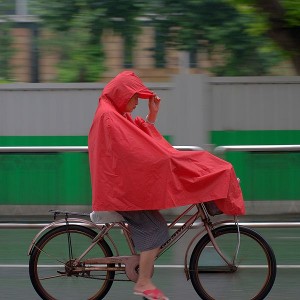Rain.
If there is one thing that keeps cyclists at home or forces them into the car on their daily commute, it’s rain. It’s tough to argue that riding in the rain makes commuting on the bike and cycling in general more challenging, however, it doesn’t need to be impossible.
There are plenty of us commuters who ride in the rain, and speaking from experience I can safely say that it is possible to ride in the rain, and enjoy it. I’ve ridden through just about every weather condition out there (being from New England they are sometimes all in the same ride!) and with a little extra preparation and focus you’ll be saving gas, helping the environment and helping your body even on the worst of weather days. Here are my tips:
Change your mindset
Most people think riding in the rain is a drag. But, isn’t that just a mental attitude? I actually enjoy both running and riding in the rain. For me, maybe it makes me feel more disciplined because not many other people are doing it, and hey, riding in the rain can be fun if you let it be!
Gear Up
There’s rain and then there’s RAIN. During last night’s commute to the train on my bike it was raining. But, it was light enough that I just wore a rain jacket, didn’t get that wet and dried off within 10 or 15 minutes after getting on the train. For conditions when more gear is called for there are plenty of options for cycling rain gear. With the right gear, taking a few extra minutes to suit up before your ride, you’ll have a much drier experience.
Don’t forget that your bike is part of your gear. Riding in the rain will inevitably put a little extra sand in the drivetrain and a little extra dirt on the frame. Give your bike a good wipe down and apply some lubricant to the chain after riding in the rain.
Respect the conditions
Riding on two wheels in the rain is a much different experience than riding on dry roads or on four wheels. So, a few things to be aware of:
- Allow extra time for braking. Whether you have rim or disk brakes, make sure you allow for extra braking space when riding in wet conditions.
- Watch the paint lines. Painted road markings and rain don’t mix very well. Road markings can be extremely slick when wet so be very careful when crossing them, especially if you are also cornering.
- Watch the rail crossings. Railroad tracks can be worse than paint lines when wet. If you find yourself having to cross wet railroad tracks, if it is safe to do so with current traffic conditions, cross them at a perpendicular angle to minimize the time spent on them.
- Ride defensively. As cyclists, we should always assume that cars don’t see us. But, when rain causes reduced visibility, wet roads and increased braking times, we should be extra diligent of this. And while your buying your wet weather riding gear, make it bright colored to increase how visible you are to drivers.
And of course, with a folding bike, you can combine both driving and riding into your daily commute and have the flexibility to drive or ride depending on the conditions.
What other tips do you have for riding in the rain? Share them in the comments below.



I think that having the right gear to ride in the rain will help a lot. Sure, you might look a bit weird in a huge poncho that partially covers your bike, but looking weird is preferable to being soaked for the rest of the day. I hadn’t thought about how useful a folding bike could be during the rain, though; having the flexibility to drive or ride would be wonderful. Thanks for the article!
In their manuals, Montague describes their bikes as “water resistant” instead of “water proof” and don’t guarantee that you won’t have electrical problems in rain. Have you experienced any? Do you cover your bike if have to rack it in the rain?
There may be some confusion here. We don’t mention water resistance at all in our Owner’s Manual because at this time we don’t use any electronics on our bikes.